The Little Prince and the raven (or "how to recognise an original edition")
The Little Prince was first published in English by Reynal & Hitchcock, Inc. in New York on 6 April 1943 and, a few days later in French by the same publisher (Le Petit Prince). Both publications were hardcover books with 93 numbered pages, covered in cloth with a stamped a picture on the front cover and protected by a colour printed dust jacket. Nevertheless, both the collector and the amateur must be very vigilant when identifying the original editions. Especially since, as one could read recently in the catalogue of an American bookseller, "this special issue of one of the most beloved books of the twentieth century is, consequentially, one of the most desired limited editions and rarely comes upon the marketplace". Copies of the first print run of the first edition of The Little Prince, as well as the ones of the first editions that followed, are as few as sought after. It is important to learn to recognize the real ones from the fake, and this requires some skills... The devil hides behind the details !
The first print run of the first edition
Only 525 copies (of which 25 were not for sale), all numbered and autographed by the author, were printed from the first print run of the original first English language edition. Only 260 copies (of which 10 were not for sale) came out of press from the first print run of the first edition in French language; these were also all numbered and autographed by the author. The proof of the print run can be found at the beginning of the book, between the fly leaf and the title page. It says the following:
For the English edition:
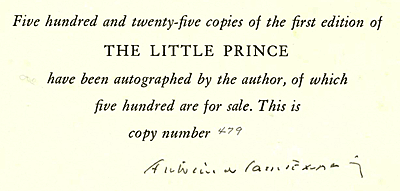 |
For the French edition:
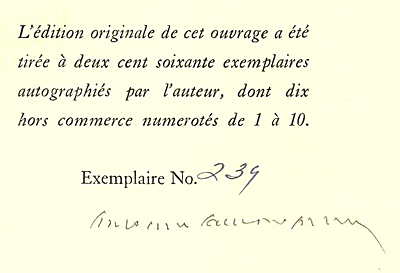 |
On the verso of the title page is the following copyright notice:
For the English edition:
 |
For the French edition:
 |
A list of works by the same author is also found on this page: Night Flight [Vol de Nuit], Wind, Sand and Stars [Terre des Hommes] and Flight to Arras [Pilote de Guerre]. Note that Southern Mail [Courier Sud], which Gallimard added it to its own edition in 1946, is missing.
 |
 |
Both these editions are hardbound books covered with a pink / tan (some say "salmon") coloured linen cloth. A cropping of the full page illustration "The Little Prince on asteroid B612" in Chapter III is stamped in red / brown on this front cover. The fabric of the cover is protected by a paper dust jacket with flaps on which the full above mentioned watercolour is reproduced in colour on the front. The address of the publisher (New York, 386 Fourth Avenue) can be found, together with a blurb, on the left flap of the jacket while the right one is free of any printing. Note that this same dust jacket was used for many reprints of the book. Besides the language used for the text itself, there are two bibliographic characteristics which make the French language edition strongly different from its English translation: the colophon and the "mark of the raven" or "mark of the crow".
On the last page (nr. 94) of the English edition a colophon with the following information can be found:
 |
This colophon does not exist in the French language edition.
Both editions show on page 63 the illustration of the Little Prince standing atop a mountain and watching the massive opening up before him. In the French edition only, this image has a small black spot at the horizon, on the right side of the foot of the peak rising to the left. This pattern evokes the silhouette of a black bird flying over the mountains: bibliophiles have named it "the mark of the raven". This was the provisional companion of the Little Prince in French language during his youth.
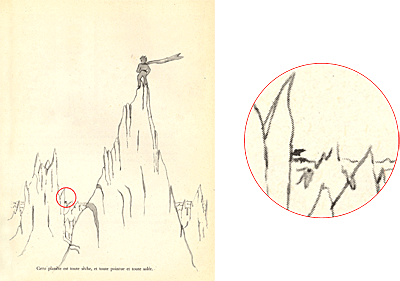 |
Let's summarize: both first print runs of the American editions of The Little Prince in French and in English are printed on the same offset paper as the first trade editions. They are hardbound books, covered with a linen cloth on which an image is embossed and protected by a colour printed dust jacket; they are furthermore published by Reynal & Hitchcock, Inc. located on Fourth Avenue in New York and they are autographed and numbered by hand by the author. The French version must in addition have a macula known as the "mark of the raven" on page 63. If any of these elements is missing you just don't have a true original edition in your hands.
The drawings printed in the first French Paris edition (as well as the ones that appeared in most of the versions that followed until the year 2000) differ both in colour and in shape from those of the American copies. Among these differences we note the colour of the cape of the Little Prince which was originally green and became blue.
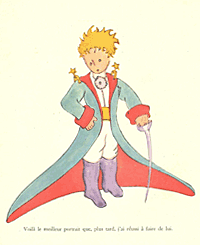 |
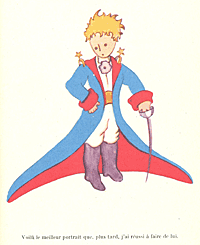 |
First French edition New York - 1943 |
First French edition Paris - 1945 |
The first edition
The first trade edition, not autographed by the author, follows the original print run. The price for the copies of this first edition was set at two dollars a piece in 1943. These books are, in all respects, identical to the first print runs of the French and English language editions with one exception: the proof of the first print run is missing at the beginning of the book, between the fly leaf and the title page.
In order to identify with certainty a first edition of The Little Prince in French, the following criteria must be met: the publisher mentioned on the title page is "Reynal & Hitchcock, Inc."; the copyright notice is exactly identical to the one the first print run of the first edition and does not have a book edition numbering; the "mark of the raven" must be present on page 63. In addition, if the book is complete with its dust jacket (as long as this is the original one), one can verify that the publisher's address is the one on Fourth Avenue.
In order to identify the first edition in English language, the copy in your hands must have the following features: the publisher mentioned on the title page is "Reynal & Hitchcock, Inc."; the copyright notice is exactly identical to the one in original edition and does not mention a book edition numbering; the colophon is present on the last page. If in addition the book has a dust cover, the address on the left flap will corroborate its identity; however never forget that a jacket is, by essence, volatile…
The subsequent book editions
Several attributes are used to identify among the various editions published between 1943 and 1950 without anyone actually knowing if they are reprints or refer to fictitious editions as it was often the case back then. Let's mention the simplest feature first: in both the English and the French editions, the book edition number appears right under the copyright notice on the verso of the title page. Thus, for the second printing of the English translation it looks as follows:
 |
The book edition number is present from the second to the sixth edition of the English version and from the second to the seventh edition of the French version. Alas, it is difficult to establish an actual date of sale of the copy with this indication. The "mark of the raven" disappears with the sixth French edition, clearly attesting a reset of the type pages; however it is not systematically present on all copies of the fifth printing either...
Another interesting characteristic is the editor's address on the flap of the dust jacket which changes to "West 8th Street" with the fifth English and the sixth French editions; it then changes again to "383 Madison Avenue" with the seventh French edition. This can be a useful indication to verify if the copy has the right jacket.
One should also take into account that the fabric colour of the book's cover varies for both languages; this not only from one edition to another, but also within the same edition. Since the binding series were produced according to market needs there are i.g. not less than three known colours for the third English edition: green, sea green and blue-gray.
The copies in English language lacking the edition number on the copyright page and the colophon at the end of volume, but that were published under the banner of "Reynal & Hitchcock, Inc.", are posterior to the sixth edition. This can be ascertained if the copy bears its original dust jacket on which the address must read "383 Madison Avenue", that is to say an address valid after 1946.
As for the copies in French language lacking the edition number on the copyright page and the "mark of the raven" on page 63, they came out after the seventh edition.
The text on this page contains excerpts from Alban Cerisier's book Il était une fois… Le Petit Prince (SP-0088)
